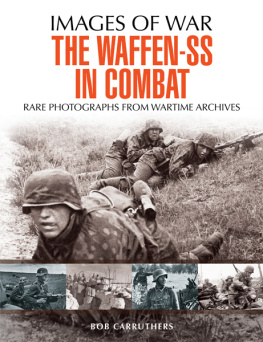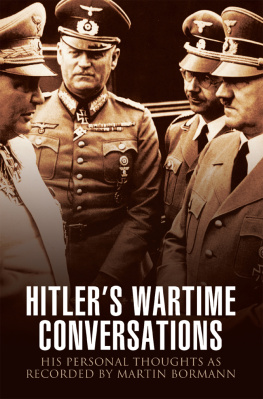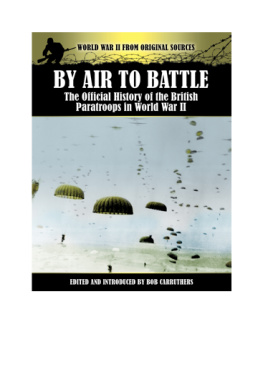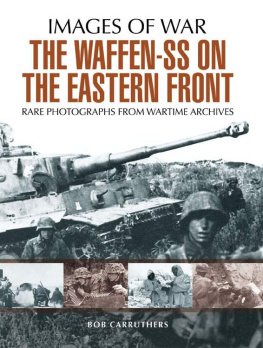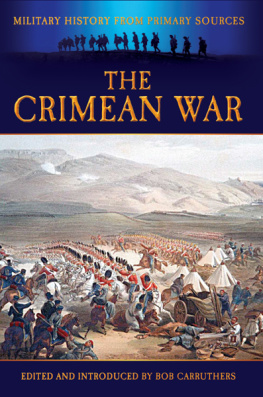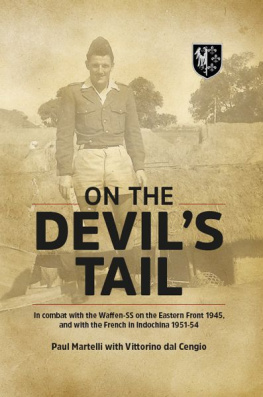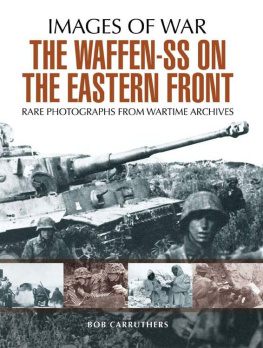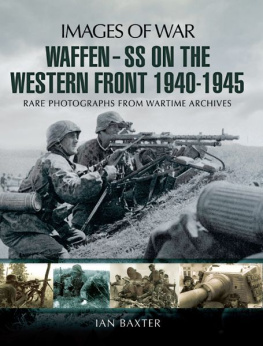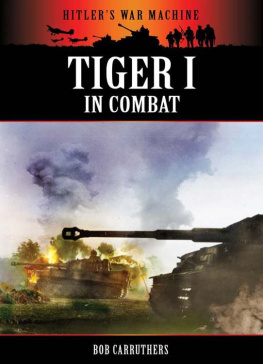Bob Carruthers - The Waffen-SS in Combat
Here you can read online Bob Carruthers - The Waffen-SS in Combat full text of the book (entire story) in english for free. Download pdf and epub, get meaning, cover and reviews about this ebook. year: 2015, publisher: Pen & Sword Books, genre: Non-fiction. Description of the work, (preface) as well as reviews are available. Best literature library LitArk.com created for fans of good reading and offers a wide selection of genres:
Romance novel
Science fiction
Adventure
Detective
Science
History
Home and family
Prose
Art
Politics
Computer
Non-fiction
Religion
Business
Children
Humor
Choose a favorite category and find really read worthwhile books. Enjoy immersion in the world of imagination, feel the emotions of the characters or learn something new for yourself, make an fascinating discovery.
- Book:The Waffen-SS in Combat
- Author:
- Publisher:Pen & Sword Books
- Genre:
- Year:2015
- Rating:3 / 5
- Favourites:Add to favourites
- Your mark:
- 60
- 1
- 2
- 3
- 4
- 5
The Waffen-SS in Combat: summary, description and annotation
We offer to read an annotation, description, summary or preface (depends on what the author of the book "The Waffen-SS in Combat" wrote himself). If you haven't found the necessary information about the book — write in the comments, we will try to find it.
The Waffen-SS in Combat — read online for free the complete book (whole text) full work
Below is the text of the book, divided by pages. System saving the place of the last page read, allows you to conveniently read the book "The Waffen-SS in Combat" online for free, without having to search again every time where you left off. Put a bookmark, and you can go to the page where you finished reading at any time.
Font size:
Interval:
Bookmark:

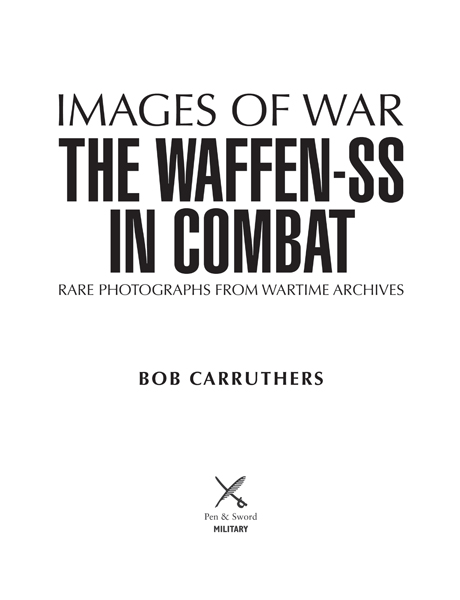
This edition published in 2015 by
Pen & Sword Military
An imprint of
Pen & Sword Books Ltd.
47 Church Street
Barnsley
South Yorkshire
S70 2AS
Copyright Coda Publishing Ltd. 2015.
Published under licence by Pen & Sword Books Ltd.
ISBN: 9781473833531
eISBN 9781473857582
A CIP catalogue record for this book is available from the British Library.
All rights reserved. No part of this book may be reproduced or transmitted in any form or by any means, electronic or mechanical including photocopying, recording or by any information storage and retrieval system, without permission from the Publisher in writing.
Pen & Sword Books Ltd. incorporates the imprints of Pen & Sword Aviation, Pen & Sword Family History, Pen & Sword Maritime, Pen & Sword Military, Pen & Sword Discovery, Pen & Sword Politics, Pen & Sword Atlas, Pen & Sword Archaeology, Wharncliffe Local History, Wharncliffe True Crime, Wharncliffe Transport, Pen & Sword Select, Pen & Sword Military Classics, Leo Cooper, The Praetorian Press, Claymore Press, Remember When, Seaforth Publishing and Frontline Publishing
For a complete list of Pen & Sword titles please contact
PEN & SWORD BOOKS LIMITED
47 Church Street, Barnsley, South Yorkshire, S70 2AS, England
E-mail: enquiries@pen-and-sword.co.uk
Website: www.pen-and-sword.co.uk
T he photographs appearing in the first part of this book were originally published in the spring of 1941. These images were created under the direction of Hauptsturmfhrer Gunter dAlquen, commander of the SS Propaganda Kompanie and editor of the official SS paper, Das Schwarze Korps .
In January of 1940 an SS-Kriegsberichter-Kompanie (Waffen-SS war reporters company) was established, and its zge (platoons) were attached to the four main Waffen-SS combat formations that fought in the Western Campaign of May and June, 1940. These platoons also remained with their respective divisions for the Balkans Campaign in the spring of 1941. DAlquen himself was a distinguished SS war reporter and served in the front lines during 1939 and 1940. In 1944 he was appointed by Himmler as head of the entire Wehrmacht propaganda department. Among the books he published was an official history of the SS, and a volume originally entitled Waffen-SS im Westen (1941), the photographs from of this book appeared in that volume.
Gunter dAlquen commanded the SS-Kriegsberichter unit throughout the war. By 1940 he had attained the Allgemeine-SS rank of Standartenfhrer , but began his Waffen-SS command in 1940 as a Waffen-SS Hauptsturmfhrer der Reserve . During the course of the war, he rose through the ranks until he became a Waffen-SS Standartenfhrer der Reserve and exercised the equivalent of regimental command. DAlquen was responsible for a large back room staff, which processed the incoming material, as well as the front line photographers, movie cameramen, writers, broadcaster and recorders, who served in the front lines. The Kreigsberichte in the field were assigned to the various platoons for variable periods of service. Where possible, non-Germans served with their own national formations, but were sometimes detached to cover a particular campaign and report specifically for their own domestic press.
After the war dAlquen found it difficult to escape his past. In July 1955 he was fined DM 60,000 by a Berlin denazification court and deprived of all civic rights for a period of three years and debarred from drawing an allowance or pension from public funds. The court found him guilty of having played an important role in the Third Reich, of war propaganda, incitement against the churches, the Jews and foreign countries, and incitement to murder. He was judged to have glorified the Waffen-SS, the Nazi State and reinforced the legend of Hitlers infallibility, he was also adjudged to bring democracy into contempt and encouraged anti-Semitism. After a further investigation into his earnings from Nazi propaganda, dAlquen was fined another DM 28,000 by the Berlin denazification court on 7 January, 1958. He died in 1998.
Many of the photographs featured here feature the men of Waffen-SS Standarte Germania . In 1940 the men who bore the word Germania on their cuff bands were fighting as a motorised regiment under the command of SS-Standartenfhrer Karl-Maria Demelhuber.
Originally Germania was formed in August 1934, as SS-Standarte III . It was soon renamed SS-Standarte II when Hitler ordered that SS-Leibstandarte Adolf Hitler would not be included in the SS numbering sequence. At the 1936 Nrnberg Rally, SS-Standarte II was officially granted the honour title Germania where it received the unit colours and authority to wear the cuff band bearing the unit title. It subsequently took a part in the annexation of Austria and was responsible for security during the Italian leader Benito Mussolinis visit to Germany. Germania also took part in the annexation of Sudetenland. It later served as a guard regiment in Prague, as Wach-Regiment des Reichsprotektors von Bhmen und Mhren , until July 1939.
In August 1939 Adolf Hitler, in preparation for Fall Weiss , placed the SS-VT under the operational command of the OKW. At the outbreak of hostilities in Poland, there were four SS armed regiments in existence Leibstandarte , Deutschland , Germania and the new regiment from Austria named Der Fhrer , however Der Fhrer was not yet combat-ready and played no part in the Polish campaign. Events during the Invasion of Poland raised a political furore with OKW expressing doubts over the combat effectiveness of the SS-VT. Their courage and willingness to fight was never in any doubt; but at times they were almost too eager for action and this nave enthusiasm led to disproportionately high casualties. The OKW reported that the SS-VT had unnecessarily exposed themselves to risks and acted recklessly, incurring far heavier losses than Army troops and endangering the achievement of operational mission objectives as a result. It was also strongly argued by OKW that the SS-VT was poorly trained and many of its officers were unsuitable for command. In retaliation the SS-VT argued strongly that it had been mishandled and was hampered by its deployment as sub-units intermixed with regular Wehrmacht forces. Himmler took issue with the fact that SS-VT units were fighting piecemeal with the mixed Wehrmacht /SS Panzer Division Kempf instead of as one SS-VT formation. The SS-VT he argued was also improperly equipped to carry out some of the tasks, which had been allocated of it.
As a result of the controversy Heinrich Himmler, as always, sought to achieve a political end and insisted that, in future, the SS-VT should be allowed to fight only in the form of its own discrete formations, under its own commanders and high command. The OKW reacted strongly to this nonsensical suggestion and in response mounted an attempt to have the SS-VT disbanded altogether. Hitler was unwilling to consider this, but neither did he wish to upset the Army and he chose a conciliatory path. Hitler ordered that for the campaign in the West the SS-VT should form its own self-contained Division, but this Division and all subsequent Waffen-SS divisions would still come under Army command.
Accordingly in October 1939, the Deutschland , Germania , Der Fhrer and various support units including artillery and reconnaissance battalions were reorganised into the SS-Verfgungs Division (SS-VT). Initially the men of SS Leibstandarte were earmarked to form part of the formation but the decision was rescinded and SS Leibstandarte did not fight alongside the other units. The SS-Verfngungs Division which took part in Fall Gelb came under the command of Generalleutnant der Waffen-SS Paul Papa Hausser and took part in the Campaigns in the West against the Low Countries and France in 1940. This time round the SS-VT distinguished itself in combat and was to win praise from OKW. The SS reconnaissance battalion played a distinguished role in the campaign and many of the photographs in this book feature that formation.
Font size:
Interval:
Bookmark:
Similar books «The Waffen-SS in Combat»
Look at similar books to The Waffen-SS in Combat. We have selected literature similar in name and meaning in the hope of providing readers with more options to find new, interesting, not yet read works.
Discussion, reviews of the book The Waffen-SS in Combat and just readers' own opinions. Leave your comments, write what you think about the work, its meaning or the main characters. Specify what exactly you liked and what you didn't like, and why you think so.

